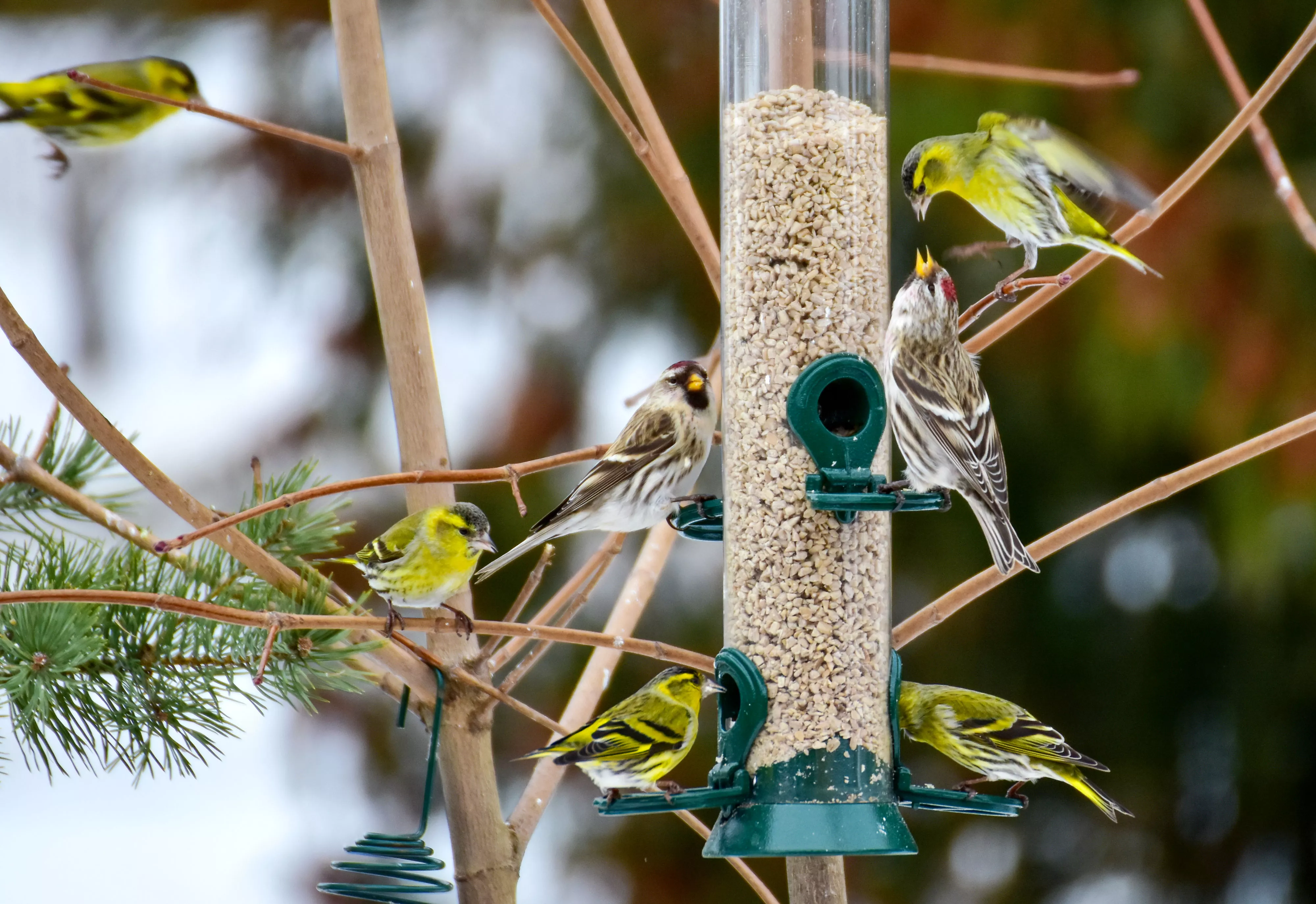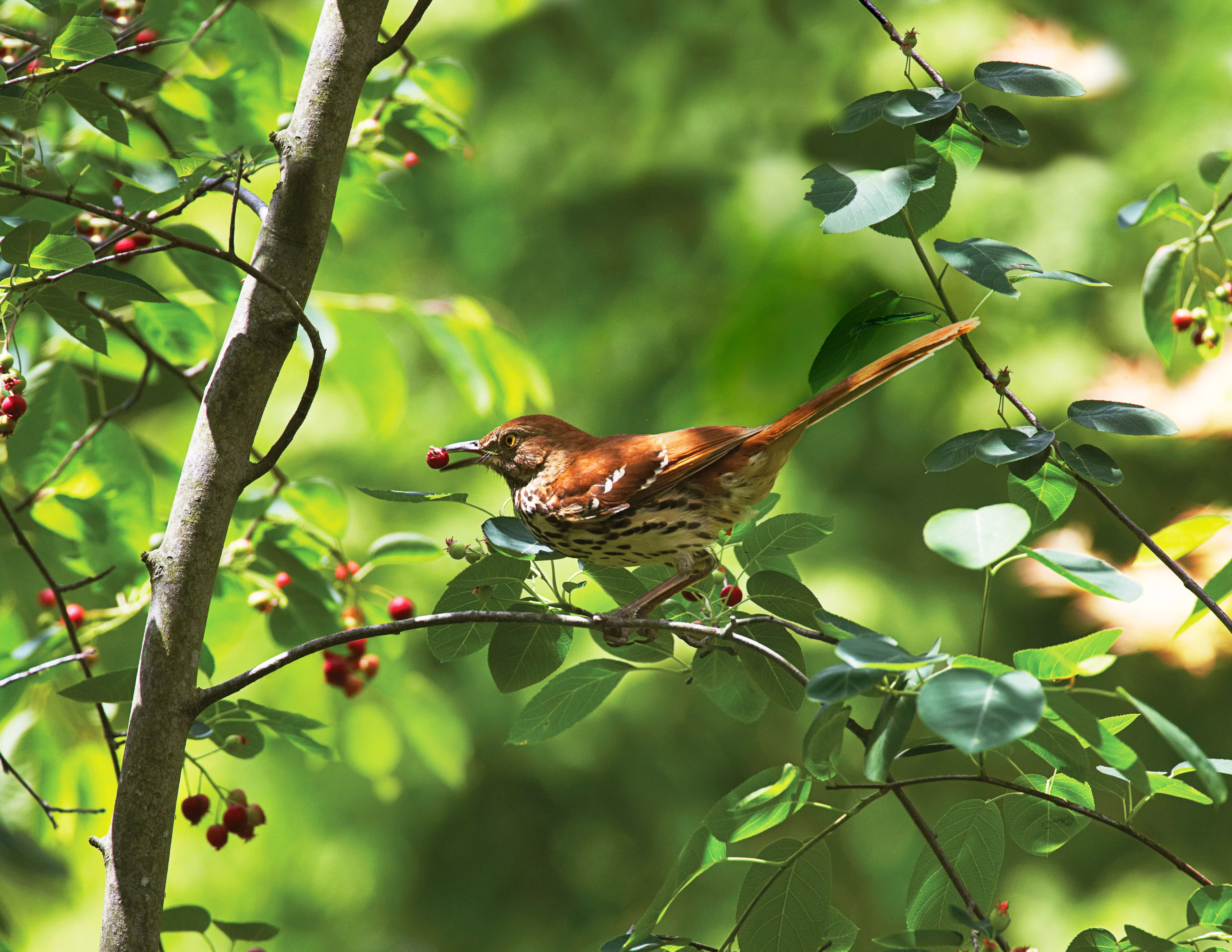- David Mizejewski is a naturalist with the National Wildlife Federation and author of Attracting Birds, Butterflies, and Other Backyard Wildlife.
- Gail Karr is the curator of special animal exhibits at the Memphis Zoo.
Attracting Different Types of Birds
Figuring out which type of bird feeder to hang in your backyard depends on the birds you want to entice to your landscape. “Consider the types of birds you want to attract; different birds are attracted to different types of feeders and food,” says David Mizejewski, a naturalist with the National Wildlife Federation and author of Attracting Birds, Butterflies, and Other Backyard Wildlife.
The climate where you live will also influence your decision. “In hot climates, look for feeders with ventilation and weatherized features to keep seeds fresh,” says Mizejewski. “In cold climates, choose feeders with larger seed capacities to minimize refilling frequency.”

Choosing the Right Feeder
The best way to know what type of feeder to use is to be familiar with the birds in your area. “Research common birds in your area to understand their feeding habits, and choose feeders and seeds that cater to their preferences,” says Mizejewski. Depending on the birds in your area, you may want to put up several types of bird feeders. They include:
Hopper Feeder
“A hopper feeder is overall very attractive to most feeder birds,” says Gail Karr, curator of special animal exhibits at the Memphis Zoo. “This includes finches, jays, cardinals, buntings, grosbeaks, sparrows, chickadees, and titmice.” She notes that squirrels also like these feeders and can help themselves to the feed. Some are spring-loaded, “so the weight of the squirrel shuts these feeders,” she says.
Hummingbird Feeder
Have hummingbirds in your area and want a front-row seat? “Hummingbird feeders have specialized flower-like ports suitable for their long beaks,” says Mizejewski.
Platform Feeder
“Platform feeders with wider perches work well for larger birds like cardinals and blue jays,” explains Mizejewski.
Peanut Feeder
“This attracts cardinals, jays, and squirrels,” says Karr. “It is usually in a wreath shape and provides enrichment as they work the peanuts through the wire wreath.”
Suet Feeder
Suet provides fat and energy to birds. “Suet feeders are a great source of energy for the birds during cold weather,” says Karr. “Woodpeckers love this. You will be amazed at how many other species take advantage of it as well,” she adds.
Use suet quickly because it can go rancid in hot weather. Suet has a short shelf life, so don’t save it for the next season.
Tube Feeder
This bird feeder is a long, slender tube often filled with small seeds. “Tube feeders with small perches are ideal for smaller birds like chickadees and finches,” says Mizejewski.
Selecting the Right Bird Food
Once you’ve chosen a bird feeder, you need to figure out which bird food to use. Choosing quality birdseed is essential. Birds need good food to stay healthy and strong. “High-quality seed mixes are formulated to provide essential nutrients,” explains Mizejewski.
Birds are selective with what they eat. “Cheap seed mixes often contain fillers that offer minimal nutritional value,” Mizejewski says.
If you are unsure which feed is best for your bird feeder, inquire at your nearest wild bird specialty shop.
“Don’t use cheap feeds! You get what you pay for,” says Karr. Not only do you want to provide tasty, vitamin-rich food for birds, but choosing quality over quantity saves you money, time, and cleanup in the long run. “The birds will just toss [cheap food] on the ground, and you will have weeds and grass growing under your feeders—a total mess,” she says. The discarded seed can attract rodents, too.
Placing and Positioning the Feeder
When considering a good spot to hang a feeder, look for areas that predators, such as owls, can’t reach. Pay attention to the wildlife that spends time in your landscape to get a sense of the predators that visit and how to keep the feeder inaccessible to them. “Hawks, owls, and falcons might see your feeder as a reliable source of prey,” says Mizejewski.
Squirrels also love to help themselves, so place the feeder in an area that is out of reach for these nimble creatures. “Keep in mind, squirrels are hard to outsmart, and they are fast learners,” says Karr. “I have put feeders in bad spots, and the squirrels carried the feeder off.”
Where is an ideal place to put a bird feeder? “Hang feeders near trees and shrubs away from open areas where hawks can quickly swoop down,” says Mizejewski. A good rule of thumb is choosing trees and branches that aren’t easily accessible for both squirrels and predators. “I use tree lightweight branches that are isolated so that the feeders are hard to get to,” says Karr.
Placing a feeder near a window can be an option, but you need to ensure birds won’t accidentally fly into it. “Position the feeder right next to the window so the birds flying away don’t have time to get enough speed to injure themselves if they fly toward the window,” says Mizejewski. Karr says one benefit of placing feeders by the window is that squirrels can’t usually get to them.

Creating a Bird-Friendly Environment
Simply hanging up a bird feeder doesn’t guarantee birds will come and feast. Creating a bird-friendly habitat with native plants, shelter, nesting materials, and water encourages birds to visit your garden. “I always use the phrase ‘birds need habitat before handouts’ to emphasize that the best way to feed birds is to plant native plants that provide berries, seeds, nuts, nectar, and insects,” says Mizejewski.
Plant Natives
Growing diverse native plants, such as grasses, flowers, shrubs, and trees, benefits pollinators and wildlife, including birds. Native plants co-evolved with many insects and animals, so they depend on each other for pollination, food, and shelter. “They will eat the seeds, nest in your yard, and it will provide cover from harsh weather and predators,” says Karr. “You will create a whole ecosystem in your yard.”
Birds eat insects and caterpillars, so growing plants that entice these creatures brings more birds to your yard. “Most bird species require insects as part of their diet—eliminate pesticide use and plant native plants to attract them,” says Mizejewski.
Shelter
Consider growing different-sized plants to create shelter for birds. “Shelter provides protection from predators and extreme weather conditions,” explains Mizejewski. You can also provide bird houses. Birds are able to conserve energy by not having to fly around looking for a safe place.
Water Sources
Placing a water source, such as a dish, pot, bucket, or fountain, is necessary for birds to have a place to drink and keep their feathers clean. Each bird species has different preferences for water access. “Birdbaths provide a shallow dish for birds to drink and bathe in—no deeper than 3 inches,” says Mizejewski.
Water sources don’t have to be on the ground. “Hang them from a tree branch, place on a pedestal, or mount to the deck railing,” he says. Keep in mind that when a water source is at ground level, the birds will be sharing with other wildlife. “If you place it on the ground, animals that can’t fly or climb will be able to get a drink too, such as rabbits and turtles,” Mizejewski says.
Know what species you want to entice to your garden to guide you on the best container to set out water. “Some species are attracted to moving water, such as drippers or small fountains that mimic natural water sources,” he adds.
Provide Nesting Materials
Create a habitat in your front, side, or backyard where birds can build nests and find materials to make one. “Birds prefer natural nesting materials like twigs, leaves, moss, and dried grasses,” says Mizejewski. When birds have a space where they can collect and easily find natural items to build a nest, they can spend more time with their babies. “Providing nesting materials can save valuable time and energy that can be devoted to other essential tasks, like raising young,” he adds.
Don’t Use Pesticides
Avoid using chemical sprays, such as insecticides or herbicides, when maintaining your garden and landscape. The toxins can harm the birds you want to attract. “I would emphasize not spraying pesticides because they can kill birds directly,” says Mizejewski, “but even more deadly is that they rob the birds of the foods that they need to feed their babies in the spring.”
Keep Cats Away
Cute as cats are, your favorite feline can be a threat to birds. When putting up a bird feeder, think about areas your cat can’t reach. “Free-roaming cats are a significant threat to birds, and placing bird feeders near cats put birds at risk,” says Mizejewski.
How can you minimize your cat hunting down the very birds you want to entice to your backyard? “Keep cats indoors, especially during dawn and dusk when birds are more active,” says Mizejewski.
Clean Bird Feeders Regularly
You’ve set out your bird feeder, the birds have feasted, and you’re enjoying their frequent visits. The work isn’t over—you need a cleaning routine to keep the bird feeder hygienic. Seeds can become moldy when they sit too long in a feeder, especially in humid weather.
How often should you clean a bird feeder? “Aim to clean your feeder at least once every two weeks during cooler weather and once a week during hot, humid weather or during heavy bird activity,” says Mizejewski.
A thorough cleaning is necessary to prevent disease, mold, or mildew from forming. Wash bird feeders in hot water with soap. Want to disinfect them? According to Mizejewski, “Disinfect in the dishwasher or soak feeders in a 20% solution of white vinegar and hot water.” For areas that are difficult to clean, get creative to ensure grime, mildew, or mold is wiped away. “Use brushes or pipe cleaners to get in the crevices of feeders,” says Karr. “Allow all washed feeders to dry out before filling again.”





